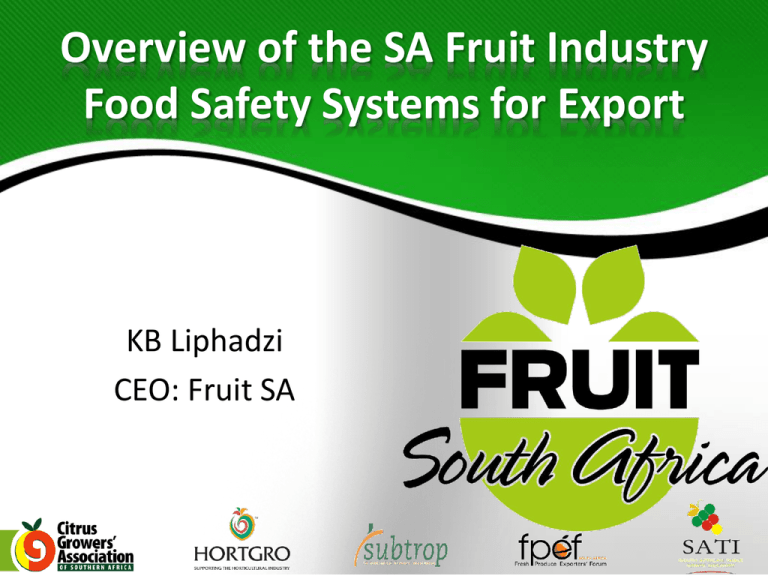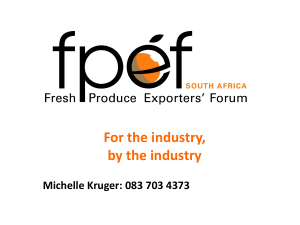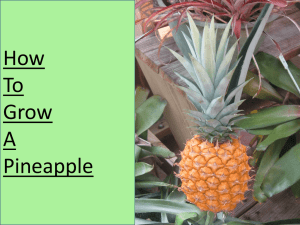Fruit industry SA-NZ workshop1 - Food Safety Systems for Export
advertisement

Overview of the SA Fruit Industry Food Safety Systems for Export KB Liphadzi CEO: Fruit SA Background of Fruit SA • • • • FSA was established in the early 2000’s as an umbrella organisation for the different fruit sectors. Initially FSA operated without any staffing and as an informal body. In 2013 Fruit South Africa was formalised as a not for profit company. In 2014 the first CEO FSA was appointed. Introduction • History of fresh fruit production and export dates back to the mid 17th century. • 1st export to England was in the end of the 19th century, made possible with improved plant material from USA and improved refrigeration technology. • Inspection of all export fruit was made compulsory in 1914 through in terms of the Fruit Export Act. • The deregulation of the fresh fruit industry in 1997 ushered a new era of free enterprise marketing. • The Deciduous Fruit Producer’s Trust (now Hortgro) and Citrus Grower’s Association were born. SA fruit industry statistics • Fruit industry is valued at more than R24 billion with more than 4.4 million tons of fruit produced annually. • SA is a major supplier of fresh fruit in the Southern Hemisphere. 40% 35% 30% 35% 25% 26% 23% 20% 15% 10% 11% 5% 9% 0% Citrus Sub-tropical and nuts Pome Stone Table grapes SA fruit industry statistics SA fruit industry statistics • More than 50% of all agricultural exports from South Africa are fresh fruit. • Majority of SA fresh fruit is exported. • 2.7 million tons of fruit is exported to more than 87 countries in the world annually, earning R19.8 billion in foreign currency. • Major export destinations: EU, UK, Far East, Russia, Middle East, USA/Canada South African fruit export markets (volume in 2013) EU Russia 9% 34% 3% UK 15% 16% 19% 4% Food safety • SA fruit industry has to meet the challenge of increasing demand by consumers for healthy and safe food (especially overseas). • Food safety is not static. • Requires all players involved along the food chain (food producers, processors, retailers and households) to recognize their primary responsibility and to share a common goal: ensure safe food at all steps of the chain From harvest to home: product chain Food safety Guiding principles • Quality standards, product protocols, laws and regulations – Food safety is a shared responsibility between DAFF, DoH and DTI • Transparency – Builds consumer’s confidence in the safety and quality of food supply – Improved communication of food safety information(science based information) • Traceability – Keeping record of all operations/inputs during production – Allows tracing back source of contamination or disease Responsible institutions for food quality and safety Checklist and Compliance criteria Assignee to perform endpoint inspection, food safety auditing and export certification Production/producer/harvest • GAP – to meet consumer needs for safe and high quality products, produced in an environmentally friendly and social responsible manner. • Most importing countries have established Maximum Residue Levels (MRLs) for various pesticides used during fruit production. • Compliance to the MRL is a prerequisite to market access. Producers are required to keep all records. – PPECB has been delegated to test MRLs • The ability to trace produce back to origin is an important component of food safety system. – Speed and accuracy is important. – Mandatory marking requirements in terms of Agricultural Products Standards Act 119 of 1990. Packaging / Processing • Good manufacturing practices (GMPs) provide the basic environment and conditions for packaging or processing a safe product. – Include - packhouse sanitation to prevent and eliminate product contamination – Conditions and practices are specified in the Health Act of 1977 • HACCP implementation – systematic approach in identifying, evaluation and control of food hazards in the process flow of the product. Transportation • Basic requirements should be met – i.e. prevent: – mechanical damage to fruit and its packaging, – contamination (odours, pests or bacteria), – damp conditions, – fruit pulp temperature increase (quality and shelf life) • PPECB tests the performance and efficiency of locally build refrigerated vehicles. • Complete and correct documentation should accompany the consignment. Product security/integrity, storage control and traceability • Specific storage conditions depend on the fruit kind, e.g. avocadoes can no be stored with bananas. • Only PPECB certified cold stores can be used. • Special export markets have written government-togovernment protocols (only allow for use of certain facilities in the country). Private standards • • • • • Private standards in general goes beyond relevant Codex standards. This may lead to unnecessary barriers to trade. Cost of compliance is high, specifically for first time participants. High costs are associated with auditing multiple private standards. Multiple standards do affect the profitability of small holder farmers and their ability to comply – resulting in exclusion from export market. If relevant private standards are demanded, the entire supply chain must meet the standard, including on-farm/ packing and related off-farm packing activities. Most EU countries require GLOBALGAP, GMP, HACCP and BRC Global Standards - all exporters and growers (suppliers – small, medium, large) exporting products to the EU need to comply. Role of government • DAFF determines whether agricultural produce may be exported from SA or not. • PPECB is the assignee who certify that the produce satisfies the market requirements. • DAFF’s role is essential in ensuring retention of market access. • Government have set a minimum quality standard/ benchmark for every fruit kind. • The exporter may apply to use different standards to those prescribed by government. Challenges • Phytosanitary measures are sometimes used as non-tariff barriers to trade. - CBS case (Minister Davies), cold sterilization, etc. • Government policies that can inhibit competitiveness (selfimposed limitations). • Capacity within government to implement the various regulations and effectively monitor throughout the value chain (right people, right skills, right placing, adequate numbers, etc.). • Within the country, relevant and reliable infrastructure in terms of rail, road, ports, pack houses, storage facilities, port facilities etc. are required to support the fruit value chain. • Delays in releasing containers by importing countries – 4 days instead on 1 day. Challenges with Private Standards • Lack of harmonisation/ equivalence between multiple private standards and between private standards and official standards resulting in multiple audit requirements (certification) by suppliers. • Lack of (inadequate/ limited) scientific justification for many private standards requirements (non-regulatory MRL requirements), going beyond regulatory requirements e.g Germany. • Number of private standards are too many and growing, becoming unsustainable for suppliers. • Cost of compliance is high and increasing. Thank you Acknowledgements: Lindi – Hortgro & SATI Schubesco - PPECB Andy – Dole Paul - CGA Fruit SA Contact details Dr Konanani Liphadzi CEO Tel: 012 433 6422 Email: ceo@fruitsa.co.za Website: www.fruitsa.co.za







